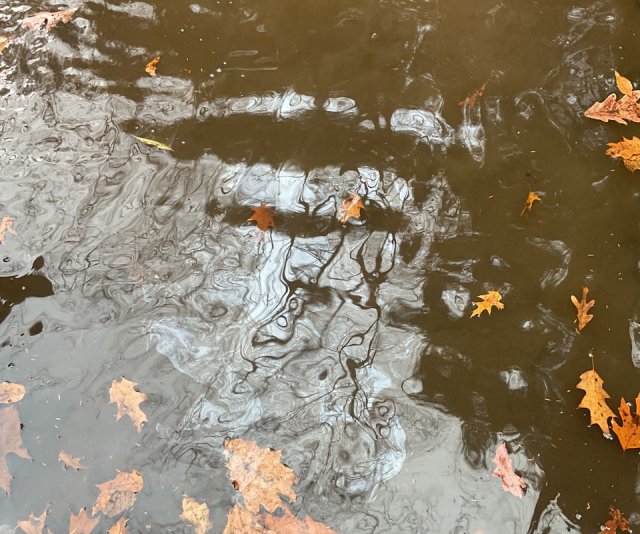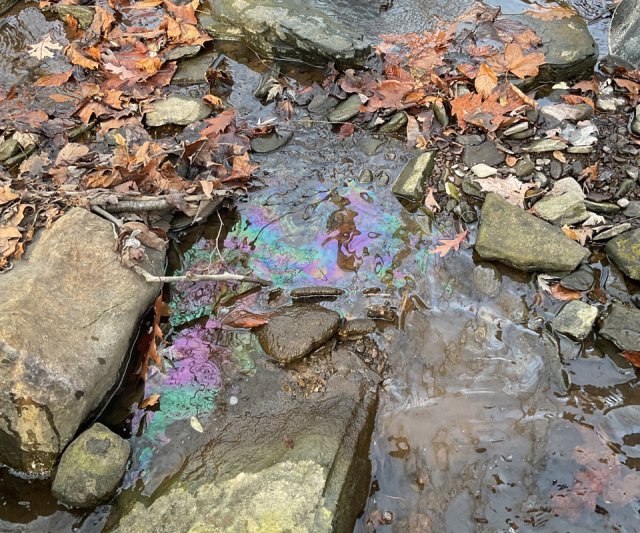Qualitative Sheen Assessment Results
Sheen Assessment
Early in the response, under the oversight of EPA and its partners, Norfolk Southern started surface water quality monitoring downstream of the derailment site. Sediment washing and air sparging have been used to restore water quality in Sulphur and Leslie Runs. Air sparging involves spraying water to add air so that oxygen and microbes can break down chemicals. Air sparging is often used in some emergency responses like this derailment to remove chemicals from water.
Stream cleaning has successfully removed chemicals and surface water results have been below levels considered to be hazardous to human health. While surface water is no longer badly impacted, heavily disturbing the creek beds (sediment) can sometimes cause shiny iridescent patches, called sheen, to rise to the water’s surface.
On October 18, 2023, EPA issued an order under the Clean Water Act requiring Norfolk Southern to investigate and cleanup the oily sheens and sediments in Sulphur and Leslie Runs. The qualitative assessment of the stream is complete, and the results are posted below. The first assessment showed that oil-related substances are common in sheens and sheen appears when sediments are disturbed in more than half of the streams.
Crews collected samples of sheens and nearby sediments to check their chemical makeup. Areas with medium and heavy sheens guided planning for exactly how and where additional stream cleanup and monitoring is done.
EPA continues to recommend avoiding Sulphur and Leslie Runs during assessment and cleanup work, and to follow posted warning signage along the creeks. EPA will coordinate with Ohio Department of Health and other partners on reviewing and updating this recommendation.
Observation Data
Crews walked both Leslie and Sulphur Runs and disturbed the creek bed every 25 feet to look for visible sheen. They assessed the creek at approximately 740 locations downstream of the derailment. These locations are highlighted in brown in the dashboard map below.
Crews also assessed the streams at approximately 90 background locations, which are upstream from the derailment site. Background locations are without derailment impacts. By checking these background areas, investigators can compare the streams where oil was and wasn’t released. Background locations are highlighted in green in the dashboard map below.
If crews observed sheen, they assigned a score on a 0-to-3 scale depending on the amount of visible sheen. Zero means there was no sheen and three means there was a lot of sheen. Initially in Leslie Run, 59% of locations had some sheen, compared to 66% of locations in Sulphur Run. In background locations, 92% of areas had no sheen. In the dashboard below, you can select different stream areas to see the breakdown of sheen results. After the fourth reassessment, Leslie Run had 3.5% of locations with some sheen, Sulphur Run had 27%, and background locations had 98.8% of areas with no sheen.
Interpreting Results
Efforts to clean up the sediment took place in November 2023, March and April 2024, and July 2025. Some sheens are caused by naturally occurring bacteria. Cleanup crews graded chemical sheen, (which looks different), based on how fast it rises to the surface when sediments are disturbed, its size, and its smell. Below are photos of water with different sheen scores.
Crews found sheen in some background locations. This is likely from human activities such as littering or contamination from stormwater runoff. The early stream washing and cleaning along with the sediment clean ups removed sheen from the derailment.
Useful Information
If some data are not shown when a segment is selected, then data were not able to be collected at that location for that time period. The number of observations in an area may change slightly over time because of the dynamic nature of the creek channel or problems with access to that area.
No sheen

Light sheen

Medium sheen

Heavy sheen

Useful Information
When a segment is selected, if no data appears in one or more pie charts then data was not able to be collected at that location for that time period.
